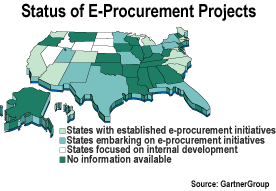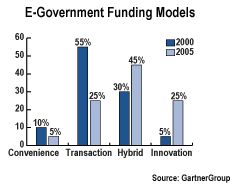ACROSS THE DIGITAL NATION

Funding for e-government has reached an important crossroads. Although e-government is still a very popular political and citizen-focused issue, funding for these projects remains elusive.
Funding for e-government has reached an important crossroads. Although e-government is still a very popular political and citizen-focused issue, funding for these projects remains elusive. In many respects, the early self-funded models of e-government enabled many state and local governments to embark on projects without sacrificing significant resources to support the development.However, with the nature of many e-government funding models under significant examination, the question remains the same: Where will the money to fund these projects come from?XXXSPLITXXX-E-procurement was one of the hottest and most widely embraced e-government solutions. As illustrated in the chart above, the proliferation of initiatives and widespread adoption of actual engagements has been rapid. For a brief period, this made e-procurement a killer opportunity, if not the killer application, of e-government.One key reason for the rapid adoption of these e-procurement projects is the prevailing funding model. Most of these projects are based on transaction fees, in which the vendor recoups the cost of free implementation by charging a small percentage per transaction as well as participation fees. In many respects, this model moves funding for technology projects from the information technology budget to the operational budget.However, as these projects have moved from drawing board to implementation, several critical issues have cast doubt on the short-term future of e-procurement as a killer application. In particular, three issues have taken center stage: ? Commercially oriented e-procurement software does not address key public-sector procurement requirements. Hence, additional customization has significantly lengthened original implementation timelines.? Tying e-procurement systems with back-end financial applications is extremely complex and will require greater systems integration work.? Competition with existing procurement processes and no mandate for widespread use has limited the transaction levels of e-procurement systems.Given these issues, the transaction-based funding model has been a doubled-edge sword. The model increased the adoption rate but has become an unproven source to finance e-procurement projects. Many vendors have been severely impacted by the financial challenges associated with these projects, and a couple of vendors were forced to abandon the market entirely.The second generation of e-procurement projects is slowly moving away from the transaction-only approach and is attempting to incorporate other funding mechanisms.XXXSPLITXXX-As illustrated in the chart below, funding for e-government projects will change significantly. Over the next five years, state and local government agencies will rapidly look to newer, more innovative funding models to support the extension of e-government projects. To date, there have been four major funding approaches:? Convenience model: Early in the development of first-generation e-government projects, a variety of dot-com vendors touted services directly to citizens and businesses. They attempted to disintermediate government and fund these online solutions through convenience fees charged to the customer. Citizens questioned this fee, and the approach to disintermediate government was quickly discarded by the marketplace.However, using convenience fees to support government to business solutions may still be viable. Businesses maintain the ability to pay these fees and may look at them as a negligible operational expense to improve efficiency.? Transaction model: With the growing focus on self-service transaction solutions, the next generation of e-government projects centered on transaction-based fees. As detailed in the preceding e-procurement discussion, a variety of vendors have adopted these funding models for procurement, tax filing, motor vehicle matters, permitting and licensing applications.Unfortunately, these models can quickly disintegrate as transaction volumes are suppressed, and have significant consequences to the financial health of sponsoring vendors. The fate of this model will in part rest on the ability of vendors and agencies to determine a guaranteed level of transactions through a given system and meet this goal. ? Hybrid model: Moving forward, state and local government agencies will need to focus on a more balanced approach to e-government implementation. Hybrid fees are based on partial fixed payments and partial transaction-based payments. This combination will enable the vendor and agency to work together on key consulting and integration areas, while subsidizing part of the development with a transaction-based approach.This dual approach will provide stability to the e-government project and still reduce upfront fees. Moreover, in a growing number of cases, vendors and agencies will determine a guaranteed level of transactions in order to avoid the problems encountered in previous transaction-only models.? Innovative model: Over the next five years, a variety of funding sources under the umbrella of innovation will begin to take center stage. This funding model is based on the necessary changes ahead in e-government, as agencies move from the development of tactical, agency-specific transactions to the more transformative nature of future cross-agency, enterprise e-government projects. The three main sources of the innovative funding model are shared services, innovation funds and enterprise funding.With shared services, state and local government agencies often use similar business processes for a variety of services. The multiplicity of agencies that provide permits, licenses, payments, revenue collection, etc., can maximize available resources for online development through the sharing of these e-government tools. Moreover, single agencies, such as courts, that cross different jurisdictions, such as all counties in a given state, may band together to provide a pooled resource for e-government programs.With innovation funds, state and local governments are increasingly setting aside seed money to help agencies develop e-government solutions. These resources may provide the additional boost to move projects from conception to reality or provide the impetus to examine pilot projects.In regard to enterprise funding: In many respects, the stovepiped nature of public-sector IT development has been caused by the rigid funding sources for these initiatives. Frequently, federal matching grants and program-specific development are major obstacles to developing broader, customer-centric solutions. As technology development becomes more integrated with common business processes ? such as integrated justice that serves police, courts and corrections ? and online development becomes more transformative ? such as enterprise centers for new business creation ? new legislation will be required to support funding cross-agency initiatives. Enterprise funding is the alternative for state and local government agencies to finance customer-centric solutions and advance the impact of e-government solutions.Certainly, the trend toward hybrid and innovative funding models will take time and a degree of change within the public-sector marketplace. However, in order for e-government projects to move forward, state and local governments and vendors must agree on alternatives to the convenience and transaction-only based approaches.



Rishi Sood is a principal analyst with Gartner Dataquest in Mountain View, Calif. His e-mail address is rishi.sood@gartner.com.

Rishi Sood


Rishi Sood is a principal analyst with Gartner Dataquest in Mountain View, Calif. His e-mail address is rishi.sood@gartner.com.